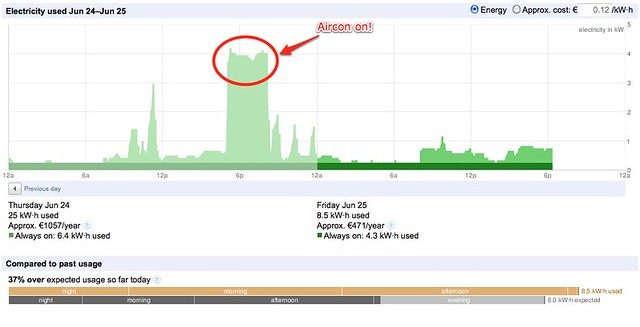
SAP runs an event called InnoJam at its developer TechEd conferences. The SAP InnoJam events are held during the weekend prior to TechEd. During these events, people from the SAP community compete against each other in teams building working prototypes of solutions to real business cases, using SAP technologies.
SAP solicit ideas for business cases to be developed at these InnoJams – I added one this morning on building a residential energy management application. The application would use a combination of gaming techniques (leader boards, achievement badges, etc) and sharing to social networks to keep customers engaged and incented to try their best to reduce their energy use.
Here’s my submission:
Energy management applications being rolled out by utility companies have a very short Mean Time to Junk Drawer (MTJD) – they are ‘all shiny’ for the first couple of weeks but the shine quickly wears off and they are soon put away in the proverbial Junk Drawer never to be opened again.
How do you make energy management applications more engaging, bringing utility company customers back again and again to try to improve on their previous energy reduction steps? You do it by turning it into a game and allowing customers to share their progress on their social network of choice!
SAP have a new application for utility customers called Smart Meter Analytics which runs on HANA. The flood of data which will be coming from Smart Meters means HANA is necessary to do meaningful analytics on Smart Meter data (Centrica talk of going from their current 70m smart meter reads per annum to 30bn when all of their smart meters are rolled out – that’s a lot of data).
Smart meters give far more granular reads on energy consumption, allowing for residential energy management applications to be built and indeed SAP’s Smart Meter Analytics application has an Energy Efficiency Scorecard for residential customers.
But, if you build an application for energy management which allows people to compete against each other. If you introduce point scoring, leaderboards, and achievement badges and add to it the ability to share your progress with your social networks (a bit like FourSquare), then the application becomes far more compelling.
Also, the mobile app would want to have a way to check energy consumption remotely, and if a device has been left on (TV, aircon, oven, etc.), remote power-down from the mobile app.
Now, for utility companies to get this to really fly, they could offer prizes to schools in their locale – the school district with the greatest energy reductions gets a new energy efficient computer lab, or new energy efficient lighting, or… (you get the idea) – pester power from the pupils in the schools on their parents, combined with educating the younger generation on the importance of energy reduction is a major win-win!
The cool thing about this is that because it is based on the utility company’s Smart Meter Analytics, it is the customer’s actual energy use, not pledges, or estimates – so reductions reported are real, and realtime.
What do you think? Do you think this is a good idea?
Photo credit Tom Raftery
Follow @TomRaftery

Tom, I like this idea quite a bit and think it could work, with one exception. There would need to be more of an incentive for the energy companies. What’s in it for them? If anything, it could turn into a money-losing proposition for them since people would be using less energy.
Actually Tim, there’s a massive incentive. It is counter-intuitive but utility companies want people to reduce their energy usage because it reduces the peak demand.
A utility company has to be able to meet peak demand – which may occur only a few days a year (think august afternoons in hot climes, or the week leading up to Christmas in cooler countries). To meet this they have to build ‘peaking plants’ – these are generation facilities, which cost billions to build and may only be used for those few days a year!
Now you can start to see the sense in reducing customers’ consumption – it is deferred capital expenditure.
SMART METER PRIVACY VIOLATIONS.
1. Must-See 4-minute youtube video on Smart meters
? http://www.youtube.com/watch?feature=player_embedded&v=8JNFr_j6kdI
CUSTOMER UTILITY BILLS AFTER SMART METERS INSTALLED.
10. Skyrocketing Utility Bills after installation
TV News Video (3 minutes)
http://www.bakersfieldnow.com/news/63581287.html?tab=video
11. Systemic Smart Meter Billing Errors Over 200% Uncovered in Australia
TV News Video (7 minutes)
http://au.news.yahoo.com/today-tonight/money/article/-/10241945/power-scandal-exposed/ – video
NATIONAL SECURITY RISKS DUE TO SMART METERS.
12. CIA Director James Woolsey calls Smart grid “Stupid” due to National Security problems caused by so-called smart meters.
News Video (1 minute)
http://www.energynow.com/video/2011/08/10/preview-mix-james-woolsey
RADIATION EMITTED BY SMART METERS.
9. RADIATION MEASURED FROM SMART METER MOUNTED ON A HOME (once active in the utility system) SHOWS RADIATION TRANSMISSION PULSES APPROXIMATELY ONCE EVERY FOUR SECONDS 24 HOURS PER DAY traveling through the bodies and brains of the inhabitants of that home. ?Youtube Video (6 minutes, 1st minute is sufficient)
?http://www.youtube.com/watch?v=uRejDxBE6OE
Smart Meters – something to be afraid of? http://www.squidoo.com/beware-of-smart-meters